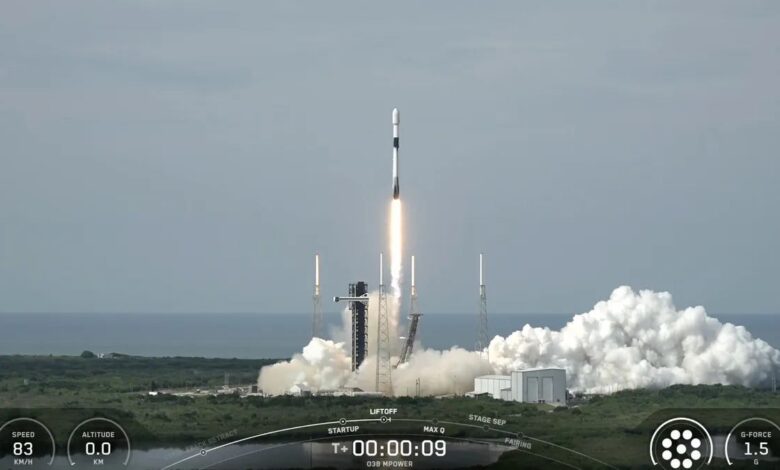SpaceX Launches O3b mPOWER Satellites & Lands Falcon 9

SpaceX Launches Two O3b mPOWER Satellites
On July 22, at 5:12 p.m. EDT (2112 GMT), SpaceX’s Falcon 9 rocket soared from Cape Canaveral Space Force Station in Florida, embarking on a mission to deploy two SES communication satellites, O3b mPOWER 9 and 10, into Medium Earth Orbit (MEO). This successful launch not only expanded the SES’s mPOWER constellation but also marked another flawless landing for the Falcon 9 booster.
Falcon 9’s Flawless Landing
Approximately 8.5 minutes post-launch, the Falcon 9’s first stage made a precision landing on the droneship “Just Read the Instructions,” stationed in the Atlantic Ocean. This marked the sixth successful launch and landing for this particular booster, highlighting SpaceX’s commitment to reusable launch technology and frequent orbital missions. The ability to reuse boosters significantly reduces the cost of space missions, making space exploration and satellite deployment more accessible.
Mission Details and Satellite Deployment
According to SpaceX’s mission update, the Falcon 9’s second stage executed another firing sequence to precisely position the satellites into MEO. This maneuver effectively slowed the satellites’ relative speed to Earth, a strategic technique used by mission planners to minimize the impact magnitude. While the launch experienced a brief abort 11 seconds before the intended liftoff, the issue was quickly resolved, and the mission proceeded smoothly.
Expanding the SES O3b mPOWER Constellation
These two satellites are part of the SES O3b mPOWER constellation, which aims to provide high-capacity internet service across the globe. With this launch, the constellation expands, bringing the total number of satellites in orbit to 10. Three additional satellites are currently under construction and are slated for launch within the next year. The mPOWER constellation is particularly focused on delivering connectivity to less connected regions, mobile assets, and industrial and large enterprise facilities.
The Significance of the mPOWER Constellation
The mPOWER constellation represents a significant advancement in global internet infrastructure. By utilizing satellites in MEO, SES can provide lower latency and higher bandwidth compared to traditional geostationary satellites. This makes the mPOWER constellation ideal for applications such as video conferencing, cloud computing, and high-speed data transfer.
Boeing’s Contribution
Each satellite, manufactured by Boeing, weighs approximately 3,700 pounds. Boeing’s expertise in satellite manufacturing has been crucial to the development and deployment of the mPOWER constellation.
SpaceX’s Role in Commercial Space
This launch represents SpaceX’s 89th Falcon launch and demonstrates the company’s growing reliability and cadence in space missions. SpaceX’s reusable launch capabilities are transforming the commercial space industry, enabling more frequent and cost-effective access to space. The development of Starship, with its fully reusable design, promises to further revolutionize space travel and exploration.
The Future of Satellite Constellations
The success of the mPOWER constellation and SpaceX’s contributions to its deployment highlight the increasing importance of satellite constellations in the modern world. These constellations are playing a vital role in providing global internet access, improving communication networks, and enabling a wide range of applications, from weather forecasting to environmental monitoring.
| Feature | Description |
|---|---|
| Constellation | SES O3b mPOWER |
| Orbit | Medium Earth Orbit (MEO) |
| Purpose | High-capacity internet service |
| Manufacturer | Boeing |
| Launch Vehicle | SpaceX Falcon 9 |
-
Key Benefits of mPOWER:
- Lower Latency
- High Bandwidth
- Global Coverage
-
Future Implications:
- Enhanced Connectivity
- Improved Communication Networks
- New Applications in Various Industries




